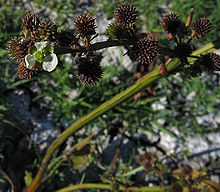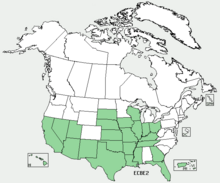| Cellophane sword | |
|---|---|

| |
| Scientific classification | |
| Kingdom: | Plantae |
| Clade: | Tracheophytes |
| Clade: | Angiosperms |
| Clade: | Monocots |
| Order: | Alismatales |
| Family: | Alismataceae |
| Genus: | Echinodorus |
| Species: | E. berteroi |
| Binomial name | |
| Echinodorus berteroi (Spreng.) Fassett in Rhodora, 57:1139, 1955 | |

| |
| Synonyms | |
| |
Echinodorus berteroi (upright burhead or cellophane sword) is an aquatic plant species in the Alismataceae It is native to the southern and central parts of the United States, as well as Central America, the West Indies, and South America as far south as Argentina.
Description
Submersed leaves often modified into phyllodes, 10 – 45 cm long x 0.5 – 4 cm wide, linear to narrowly elliptical, of very variable shape and size, light-green, membraneously transparent, network between the veins often lighter or darker, thus the submersed leaves often appearing mosaic-like coloured. Emerse leaves long-petioled, 5 – 55 cm long, blades light-green, cordate, 5 – 12 cm long x 3 – 5 cm wide, in terrestrial dwarf forms the blades are ovate, truncate at the base, 2 – 5 cm long x 1 – 2 cm wide. In the blades there are very clear pellucid lines 1 – 5 mm (exceptionally up to 11 mm) long. Stem upright, inflorescence compound, branched in lower whorls. In terrestrial forms stem only 6 – 10 cm long. Corolla white, about 1.5 cm in diameter, stamens 12, achenes numerous in echinate head, nutlets grey-brown, 2.5 - 3.5 mm long x 1 - 1.3 mm wide, broadly keeled, with 2 winged ribs alternating with 3 non-winged ribs; facial gland single, close to the beak, indistinct or quite absent. Mature specimens may have between 10 - 30 leaves. most of them differing in shape and size.
Cultivation
Prefers a larger tank with a deep, rich substrate and good light. It is easy to grow but will soon outgrow the average aquarium. Can be divided, or in submerse plants, adventitious plantlets will form on the inflorescence and can be divided and planted out. Seed will be set in emerse plants, and can be planted out in shallow trays with sand and shallow warm water. Prefers soft, rather acid water. Sub-tropical to tropical temperatures. It doesn't seem to thrive in hard water. Will grow in and by the pond in warmer regions, but must be protected from frost.
References
- ^ "World Checklist of Selected Plant Families: Royal Botanic Gardens, Kew". apps.kew.org. Retrieved 2017-01-27.
- Biota of North America Program Image
- CONABIO. 2009. Catálogo taxonómico de especies de México. 1. In Capital Nat. México. CONABIO, Mexico D.F.
- Funk, V. A., P. E. Berry, S. Alexander, T. H. Hollowell & C. L. Kelloff. 2007. Checklist of the Plants of the Guiana Shield (Venezuela: Amazonas, Bolivar, Delta Amacuro; Guyana, Surinam, French Guiana). Contributions from the United States National Herbarium 55: 1–584
- Madsen, J. E., R. Mix & H. Balslev. 2001. Flora of Puná Island 1–289. Aarhus University Press, Aarhus.
- Zuloaga, F. O., O. N. Morrone, M. J. Belgrano, C. Marticorena & E. Marchesi. (eds.) 2008. Catálogo de las plantas vasculares del Cono Sur. Monographs in systematic botany from the Missouri Botanical Garden 107(1–3): i–xcvi, 1–3348.
- Hickman, J. C. 1993. The Jepson Manual: Higher Plants of California 1–1400. University of California Press, Berkeley.
- "Echinodorus berteroi in Flora of North America @ efloras.org". www.efloras.org. Retrieved 2017-01-27.
External links
- Missouri plants Archived 2006-03-19 at the Wayback Machine
- California flora
- Ohio
| Taxon identifiers | |
|---|---|
| Echinodorus berteroi |
|
| Alisma berteroi | |